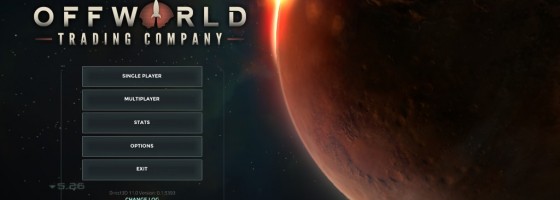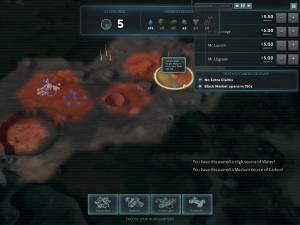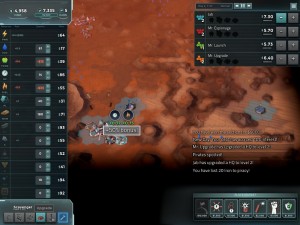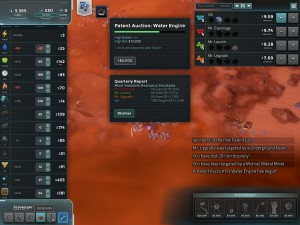Soren Johnson for many gamers is known as the lead designer behind Civilization 4 and since then and working at Stardock, he has founded his own studio Mohawk Games. Their first title marks not only a different kind of strategy game but also Soren’s first step into early access. Offworld Trading Company is a fascinating strategy game and one that shows a lot of promise but I am worried about the future.
(This spotlight is based on the early access version of the game. Screenshots and impressions may not match the current build. Speaking with Soren, the game from a mechanic standpoint is pretty solid and the rest of the time in Early Access will be used for fine tuning the experience. At the time of this post, Offworld Trading Company has about one year of development to go in early access.)
Mars Miner:
Offworld Trading Company is an economic strategy game where players do battle with resources and money as opposed to armies. The plot is that you are in charge of a mining company on Mars and your job is to secure the planet so that you are the only company who can reap all the riches.
Campaign mode gives you a little more structure and limits building types based on hiring workers but at the time of this post is still being worked on. For multiplayer and quick games (there is online multiplayer but no matchmaking yet) every game starts you off on a randomly generated map.
At first you’ll have to scan the map for the game’s five main resources of water, iron, aluminum, silicon and carbon. These resources are randomly distributed both by position and the amount on a tile. After that you’ll choose one of four different types of HQs between expansion, scavenger, robotics and scientific. These will determine innate bonuses and resources for upgrades that you’ll focus on during the game.
The rules of the game are simple; in order to mine a resource you will need to claim the tile by placing a building there. Once claimed, that tile will be yours until the game is over and you can do anything you want to it. Each player has a limited number of claims at the start with several options to raise it which we’ll come back to in a second.
Each of the five main resources has a respective building used to harvest that resource. Moving resources requires transports that are used automatically but will use up fuel which can be produced or bought.
Buildings connected to each other will share transports and resources which set up the importance of placement. Every structure built will drain power which you will either need to produce or buy and there are several means available. Also, multiple copies of the same building type next to each other will gain an adjacency bonus that raises their output by 50% per copy.
While there are only five main resources, you will also have to refine them into other advanced resources like steel, chemicals, food etc. The basic way to increase your number of claims is to upgrade your HQ which requires you to either have the resources available or spend money to buy them from the market. The market is also the main source of keeping each play different.
Booms and Crashes:
What makes Offworld Trading Company avoid the repetition of traditional strategy games is the market. On the left hand side of the screen you have all the resources in the game, your current amount, whether you are gaining or losing them and their cost. As you play a match, the costs of the various resources will boom or crash based on random events and the interactions by other players.
If someone desperately needs steel and starts buying it, that will raise the cost of steel and allow someone to sell that to make more money. Events like surpluses and shortages will also affect the pricing and can drive resources down to a few dollars or over $100 per unit.
This creates a very interesting game of strategy as you’ll have to read the market to decide what to sell and what to produce. Monopolizing iron sounds good, but if there is a surplus you’ll be left with a whole lot of nothing or it could become very valuable and you can make a mint selling it or steel that is refined from it.
Late game planning involves building patent labs to secure sole use to powerful tech, altering the market and even shipping resources off world to make a huge score.
To win, a player must buy up another corporation’s stock to control the majority. Stock value is determined by all the assets of the corporation and any debt they’ve accrued by having to buy needed resources.
And while you’re doing all of this, the other players will also be growing their corporation and doing everything they can to mess with you and where Offworld Trading Companies’ direct actions come into effect.
The Black Market:
The Black Market is essentially a selection of global powers that all players have access to. At random intervals the market will become active and players can buy one of various ways to mess with the other players. Each option grows in price with each successive purchase so that it pays to get in early and eventually these items will be priced out of everyone’s range. Not only that but from time to time auctions will pop up, allowing players to bid for claims, patents, pirates and more.
And this is what makes Offworld Trading Company so interesting as the set powers and limited actions make the game feel like a board game, yet the constant impact of the market and the economy keep the game moving forward like a strategy title. Even though the game wouldn’t be considered micro oriented like Starcraft or Company of Heroes, I wouldn’t call things macro as your control of the map begins and ends with claiming tiles with some light interaction with your buildings.
And the different feel is what makes Offworld Trading Company fascinating to play. However one area that I’m worried about is its longevity because of some set conditions.
Stale Business Plan:
Anyone can tell you that the hallmark of a good strategy game is that the design prevents the player from finding and exploiting always optimal tactics. It’s avoiding what we’ve referred to as “the chick parabola” coined by Tom Chick and how once the best strategy has been found, the game ceases to be interesting.
In an upcoming interview, I spoke with Soren Johnson about Offworld Trading Company and we both agreed that having randomized maps is an important part of the equation to avoid repetition. However my main problem with the game is that there are set elements that threaten to lock the game down.
The issue is that each HQ despite having differing resource requirements and bonuses will make use of most of the same resources.
Everyone is going to need chemicals for upgrades and everyone needs glass and electronics for late game buildings for example. Meaning those resources are going to become valuable in every play regardless of how the market is or the people playing.
From my time playing quick games and the tutorial, I noticed that successful strategies are about quickly securing those resources needed for upgrades as if you don’t, your opponents will claim them forcing you to buy and raise the price possibly out of your budget. Because upgrades are the main way to increase your number of claims AKA get more resources, it can slow you down a lot and force you to catch up.
Most games are decided by whoever gets off world shipping first, as the income boost for it is so great that it will give that player the ability to amass a lot of money which in turn raises their stock value and allows them to buy the other players out more easily. It’s a classic case of the “rich getting richer” with no way to stop it from what I could see.
Everyone has access to the same buildings (with exception to campaign mode) which means everyone has the same ways to gather resources. I think what would help is having the option of alternate means of gathering or refining allowing players different strategies and means of using their resources. Right now the only resources that have alternate ways are power, water, carbon and oxygen; I would like to see more. For example another steel producer that requires other resources instead of iron but at a higher cost or higher consumption.
Another set element is the patents available which are set up as first come, first served. Randomized patents would be interesting to force players to not rely on major ones like teleportation which for my money is the best one on there thanks to removing shipment delay time and fuel costs.
I’m really torn about the UI as on one hand it is very elegant but on the other hand it forces the player to split their attention between the market prices, black market, main screen and stock situation. I’ve had games lost because I didn’t catch the general price increases for resources that I had an abundance of and could have sold for a lot of money or an attack that crippled my resources. Also the streamlined UI makes it difficult to spot cracks in your infrastructure such as why you’re resources are draining, what buildings of yours were attacked etc.
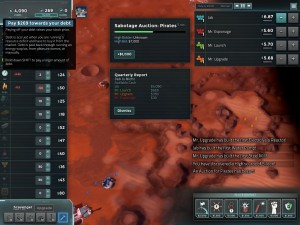
Debt is something to avoid as in real life and can easily drain your stock prices early on leaving you ripe for buyout
And my last problem goes back to the tutorials which really don’t explain to the player the general philosophy of how Offworld Trading Company works. They could use one more basic tutorial as I had to figure things out from watching let’s plays.
A Red Future:
Offworld Trading Company is a breath of fresh air for the strategy market as it exists between the micro oriented styling of Starcraft and the grandiose matches of games like Crusader Kings 2 or Civilization.
It just needs that little extra bit of fine tuning to make each play truly unpredictable and with everyone looking at the game in Early Access; we should see an amazing strategy game when it’s ready for release.

